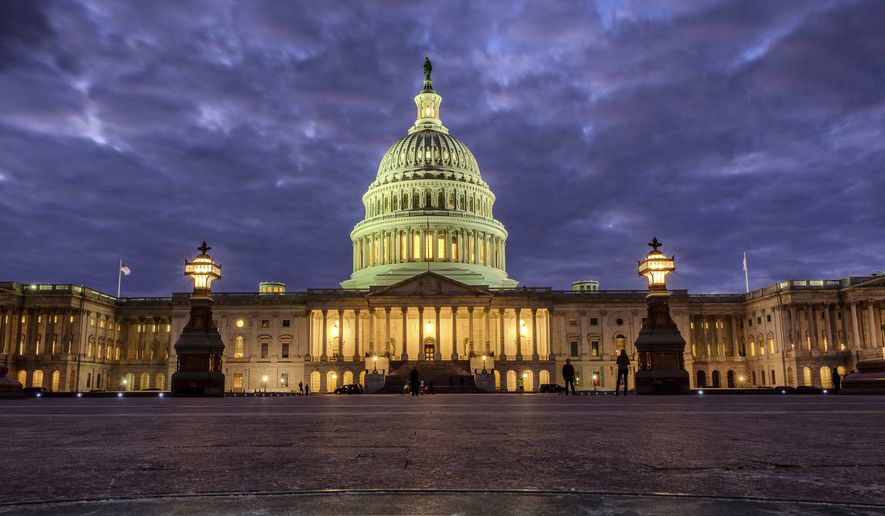OPINION:
Congressional Democrats are campaigning for control of Congress in November on a pledge to repeal the recent tax reform tax cuts. That would increase taxes on working people and their employers, taking back the jobs, bonuses, pay raises, and economic growth and recovery that tax reform is already producing.
Republicans are campaigning on just the opposite. They pledge to make the tax-reform tax cuts permanent, which they couldn’t do last year because not a single Democrat in Congress would vote for the tax cuts or to break a Senate filibuster.
The contest over tax reform, which has become epic, was intensified by House Speaker Paul Ryan’s decision to not seek re-election to Congress. Tax reform is his legacy as much as President Donald Trump’s, as it became that of Ronald Reagan and John Kennedy. The stakes for this November — and for America’s future well-being — are overwhelming.
The tax-reform cut taxes for all workers, firstly nearly doubling the standard deduction to $12,000 for singles, $18,000 for heads of households and $24,000 for couples, which makes income up to those levels tax free. The tax reform also doubled the child tax credit, from $1,000 to $2,000 per child, which cut taxes further for all families making less than $400,000 annually.
The tax-reform legislation as passed and signed by Mr. Trump cut the income tax rate by 20 percent for all single workers making $9,525 to $38,700 and by 12 percent for all single workers making $38,700 to $82,500. It also cut the income tax rate by 20 percent for all families making between $19,050 and $77,400.
These are all tax cuts for the middle class, adding up to over $2,000 annually for average families. Republicans will vote this year to make that permanent with no expiration in tax reform 2.0. We will see in that vote whether congressional Democrats will still have the courage of their convictions.
But repealing the tax-reform tax cuts — as Democrats pledge if their congressional majorities are restored this year — would reverse these middle-class tax cuts, replacing them with tax increases for the middle class instead. That would raise taxes on average middle-class families by more than $2,000 annually.
When Mr. Trump was elected, America’s corporate income tax rate totaled nearly 40 percent (including state taxes). But corporate tax rates among our international competitors totaled about half that, at 18.9 percent in Europe, 20.1 percent in Asia. Our competitors worldwide have been cutting their corporate tax rates for two to three decades predicated on economic studies confirming that it is workers who actually bear most corporate income taxes, in terms of lost jobs and wages. These corporate tax rate cuts created jobs and raised wages abroad.
But when Republicans reduced corporate rates on American companies to 21 percent in tax reform so they can gain these benefits for American workers, making their American employers internationally competitive again, Democrats, who don’t understand economics, call it “a corporate giveaway.”
For mostly smaller businesses formed as Limited Liability Corporations (LLCs), Subchapter S Corporations, Partnerships, and Sole Proprietorships, taxed under the individual income tax as “pass throughs,” the business tax rate ran even higher, up to 44 percent. Last year’s tax-reform cut their taxes equivalently with a 20 percent deduction of business income. Most jobs in America are actually created by these smaller, but rapidly growing businesses.
The Tax Foundation Inc., with the most sophisticated, dynamic economic model in America, estimated that the Republican tax reform would increase GDP and national Income by $5 trillion over the next decade. Top economists, like Boston University’s Larry Kotlikoff, estimate that will translate into increased wages for workers on average of $4,000 per year, which would be on top of the $2,000 per worker direct income tax cut each year from tax reform.
Last year’s tax reform also provided for immediate expensing of capital investment in tools and equipment, which raises wages by making workers more productive. Tax Reform 2.0 would also make this expensing permanent, eliminating completely as well the double taxation of the death tax.
Last year’s tax reform also enacted “territorial” taxation, which means overseas income of American companies is taxed by the lower business tax rates in the countries where it is earned. That freed about $3 trillion in “off shore” earnings to return to America, where it would no longer be subject to double taxation, already creating jobs and raising wages for American workers.
So that is the choice for voters this year: Restore traditional American economic growth, high-paying jobs and prosperity through permanent Republican tax-reform tax cuts. Or return to the Democratic era of long-term stagnation, and lagging wages and middle-class incomes, through still more Democratic tax increases.
• Lewis K. Uhler is founder and chairman of the National Tax Limitation Committee and National Tax Limitation Foundation. Peter J. Ferrara is a senior fellow with the Heartland Institute and National Tax Limitation Foundation. He teaches economics at Kings College in New York.




Please read our comment policy before commenting.